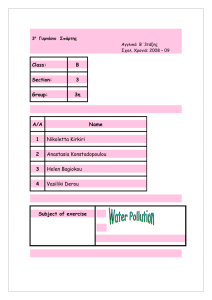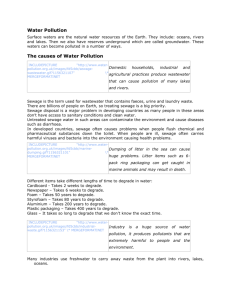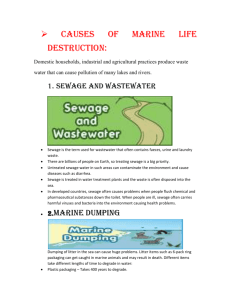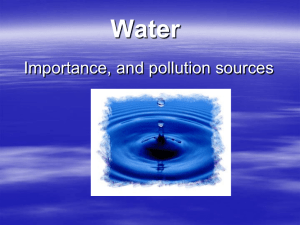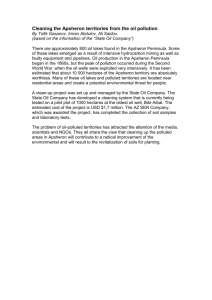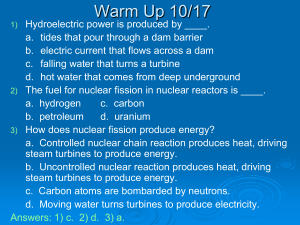Text & Worksheet
advertisement
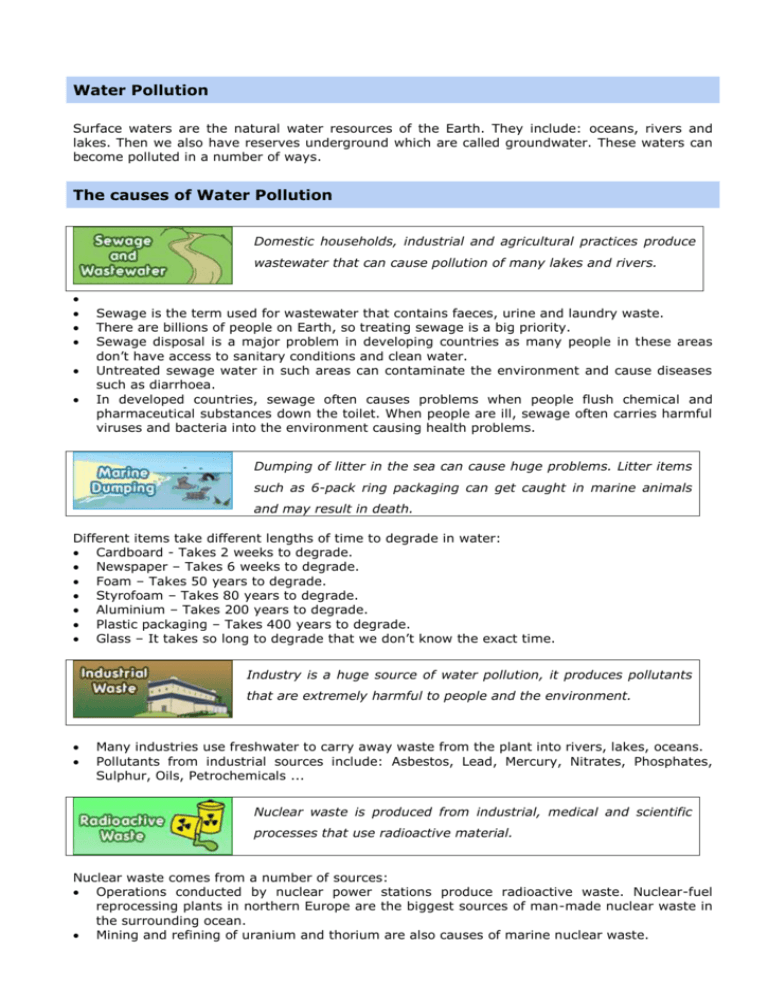
Water Pollution Surface waters are the natural water resources of the Earth. They include: oceans, rivers and lakes. Then we also have reserves underground which are called groundwater. These waters can become polluted in a number of ways. The causes of Water Pollution Domestic households, industrial and agricultural practices produce wastewater that can cause pollution of many lakes and rivers. Sewage is the term used for wastewater that contains faeces, urine and laundry waste. There are billions of people on Earth, so treating sewage is a big priority. Sewage disposal is a major problem in developing countries as many people in these areas don’t have access to sanitary conditions and clean water. Untreated sewage water in such areas can contaminate the environment and cause diseases such as diarrhoea. In developed countries, sewage often causes problems when people flush chemical and pharmaceutical substances down the toilet. When people are ill, sewage often carries harmful viruses and bacteria into the environment causing health problems. Dumping of litter in the sea can cause huge problems. Litter items such as 6-pack ring packaging can get caught in marine animals and may result in death. Different items take different lengths of time to degrade in water: Cardboard - Takes 2 weeks to degrade. Newspaper – Takes 6 weeks to degrade. Foam – Takes 50 years to degrade. Styrofoam – Takes 80 years to degrade. Aluminium – Takes 200 years to degrade. Plastic packaging – Takes 400 years to degrade. Glass – It takes so long to degrade that we don’t know the exact time. Industry is a huge source of water pollution, it produces pollutants that are extremely harmful to people and the environment. Many industries use freshwater to carry away waste from the plant into rivers, lakes, oceans. Pollutants from industrial sources include: Asbestos, Lead, Mercury, Nitrates, Phosphates, Sulphur, Oils, Petrochemicals ... Nuclear waste is produced from industrial, medical and scientific processes that use radioactive material. Nuclear waste comes from a number of sources: Operations conducted by nuclear power stations produce radioactive waste. Nuclear-fuel reprocessing plants in northern Europe are the biggest sources of man-made nuclear waste in the surrounding ocean. Mining and refining of uranium and thorium are also causes of marine nuclear waste. Waste is also produced in the nuclear fuel cycle which is used in many industrial, medical and scientific processes. Oceans are polluted by oil on a daily basis from oil spills, routine shipping, run-offs and dumping. Oil spills make up about 12% of the oil that enters the ocean. The rest come from shipping travel, drains and dumping. Oil spills cause a very localised problem but can be catastrophic to local marine wildlife such as fish, birds and sea otters. Oil cannot dissolve in water and forms a thick sludge in the water. This suffocates fish, gets caught in the feathers of marine birds stopping them from flying and blocks light from photosynthetic aquatic plants. A tank or piping network that has at least 10 percent of its volume underground is known as an underground storage tank (UST). They often store substances such as petroleum, that are harmful to the surrounding environment should it become contaminated. Many USTs constructed before 1980 are made from steel pipes that are directly exposed to the environment. Over time the steel corrodes and causes leakages, affecting surrounding soil and groundwater. Atmospheric deposition is the pollution of water caused by air pollution. In the atmosphere, water particles mix with carbon dioxide, sulphur dioxide and nitrogen oxides, this forms a weak acid. Air pollution means that water vapour absorbs these gases and becomes even more acidic. When it rains the water is polluted with these gases, this is called acid rain. An increase in water temperature can result in the death of many aquatic organisms, like choral reefs for example, and disrupt many marine habitats. Global warming is a process where the temperature increases due to the greenhouse effect. The burning of fossil fuel releases greenhouse gasses, such as carbon dioxide, into the atmosphere. This causes heat from the sun to get ‘trapped’ in the Earths atmosphere and consequently the global temperature rises. Eutrophication is when the environment becomes enriched with nutrients. This can be a problem in marine habitats such as lakes as it can cause algal blooms. Fertilisers are often used in farming, sometimes these fertilisers run-off into nearby water causing an increase in nutrient levels. This causes phytoplankton to grow and reproduce more rapidly, resulting in algal blooms. The algae may use up all the oxygen in the water, leaving none for other marine life. This results in the death of many aquatic organisms such as fish, which need the oxygen in the water to live. Algae may also block sunlight from photosynthetic marine plants under the water surface. Some algae even produce toxins that are harmful to people. What Can You Do? If you want to help keep our waters clean, there are many things you can do to help. You can prevent water pollution of nearby rivers and lakes as well as groundwater and drinking water by following some simple guidelines in your everyday life. Conserve water by turning off the tap when running water is not necessary. This helps prevent water shortages and reduces the amount of contaminated water that needs treatment. Be careful about what you throw down your sink or toilet. Don't throw paints, oils or other forms of litter down the drain. Use environmentally household products, such as washing powder, household cleaning agents and toiletries. By having more plants in your garden you are preventing fertiliser, pesticides and contaminated water from running off into nearby water sources. Don't throw litter into rivers, lakes or oceans. Help clean up any litter you see on beaches or in rivers and lakes, make sure it is safe to collect the litter and put it in a nearby dustbin TASKS & QUESTIONS A.) Text: 1. Read through the text and note 3-5 keywords for every section! 2. What types of natural water resources do we have? 3. What are the 8 causes of water pollution described in the text? 4. Can you explain the following terms in English? groundwater, sewage, dumping, pollutants, waste, oil spill, contaminated, acid rain, eutrophication 5. What can you personally do to help keeping our waters clean? B. Topic: 1. What other types of pollution do you know? 2. Which countries/areas do you think are most affected by water pollution? Why? 3. Can you drink tap water all around the world? Where/where not? 4. Who “owns” our freshwater in Carinthia? 5. Where do we get our freshwater from? 6. What do we use freshwater for in our households? 7. Why is acid rain more dangerous than many of us think? C. Are there any interesting questions/aspects you can think of? _________________________________________________________________ _________________________________________________________________ _________________________________________________________________
